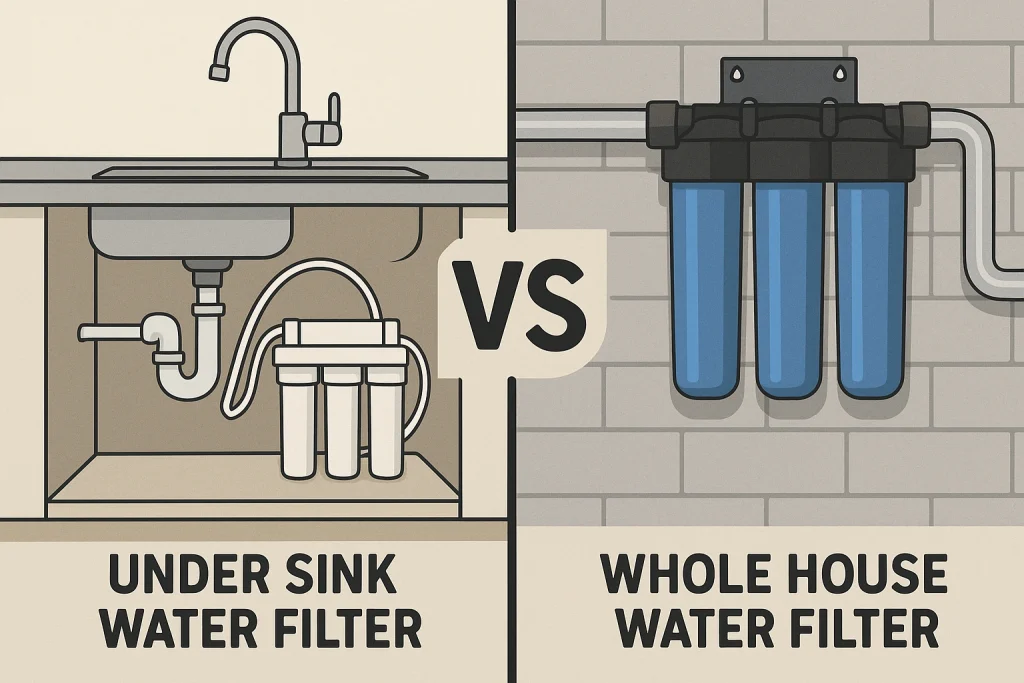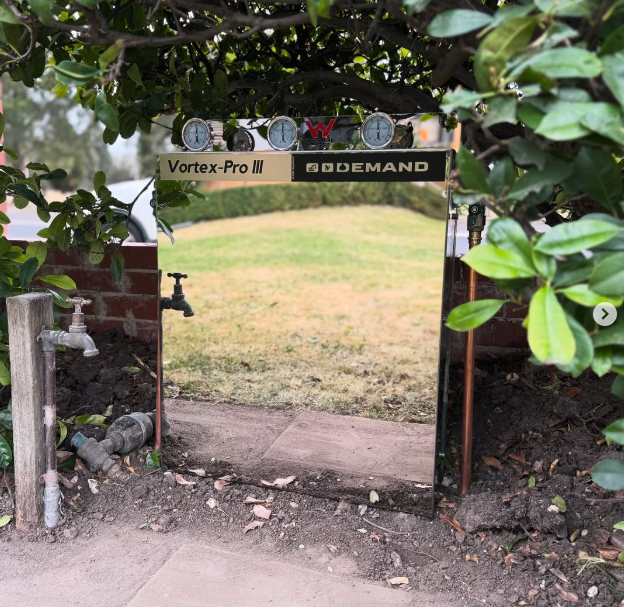INTRODUCTION:

On this blog, we discuss the comparison between whole house filter vs under sink filter and help you decide which of the two would be the best choice for you. As for filtering the water you drink and use every day, the decision between a whole-house filter and an under-sink system can make all the difference. Both have their pros and cons, however, and which one’s right for you depends on your lifestyle and priorities. Knowing the differences between these two categories of water coolers and purification systems is very important to check if you are getting clean and healthy water for the consumption of your family.
In this guide, I’ll explain all you need to know about all of them, their pros, and their cons. And by the end, you will have all the information you need to make the best decision for you and your home, family and lifestyle.
What Is a Whole House Filter?
A whole house water filter is a filtration system that treats water at its point of entry into your home at the source. It filters all water entering your home, so every tap, every clothes washer, and every shower gets filtered water. This is one of the filtration systems that assures you of clean water throughout the house, eliminating different contaminants like chlorine, sediment, lead, and bacteria.
Whole house filters are perfect for homes that have the need for pure water, but they do more than just give your drinking and cooking water the benefits of clean water. They also make sure the rest of your water system is protected and works to improve the overall water quality of your household.
Types of Whole House Filters
- Sediment Filters: Eliminate visible particles such as sand, dirt, and rust.
- Activated Carbon Filters: These filters work by eliminating chlorine and organic chemicals and improving the water taste and odor.
- Reverse Osmosis Systems: Generally employed in some larger whole house systems to filter out heavy metals, salts, and other impurities.
- UV Filters: UV filters are perfect for removing unhealthy microorganisms such as bacteria and viruses in homes with well water.
Pros of a Whole House Filter
- Comprehensive Filtration: The whole house water filter system filters the water in all the faucets in your house, from the kitchen to the bathroom to the toilet.
- Protects Appliances: These filters help preserve and extend the life of appliances such as washing machines, water heaters, and dishwashers.
- The convenience: You’ll no longer need to add and remove filters in multiple spots throughout your home. Only one system, purified water from every faucet.
- Cleaner Water: They filter out many pollutants for cleaner water on all fronts.
Cons of a Whole House Filter
- Costlier at the beginning: They are more expensive to buy and set up initially than under-sink filters.
- Need Space: They tend to take up a lot of space when installed, usually near your water main.
- Ongoing Maintenance: The filter will need regular replacement, and you might need professional help to maintain it, which increases the cost in the long run.
What Is an Under Sink Filter?
An under-sink filter is a small filtration system that is installed under your kitchen sink, and it is normally attached to the faucet you drink and cook with. Compared to whole house filters, these Under Sink water drinking filters target one or more of the common problems associated with drinking water, including taste, odor, and chemicals. Sometimes, these filters cost less and are easy to install and space-saving, perfect for renters or smaller homes.
Types of Under Sink Filters
- Carbon Filters: The most common under-sink filter is an activated carbon filter. They work well against chlorine, bad smells, and other volatile organic compounds (VOCs).
- Reverse Osmosis Systems: Used for advanced filtration needs such as removing heavy metal ions, salts, and certain dissolved solids from water.
- UV Filters: These filters have the power to eliminate bacteria, viruses, and other microorganisms, primarily in places where water quality might be questionable.
Pros of an Under Sink Filter
- Detailed Purification: Useful for providing pure and safe water for drinking and cooking, perfect for the water you use.
- Space-Saving Convenience: You’ll free up plenty of space on your countertop or under your sink to store all your kitchen essentials.
- Cost-wise: Both to install and maintain, the under-sink filters are a cost-effective alternative to whole home systems.
- Installation is simple: Most below-sink filters are relatively easy to install without professional assistance, so you won’t pay for installation costs.
Cons of an Under Sink Filter
- Small Coverage: This filter will only clean water from the faucet it is attached to. Other water sources, such as showers and washing machines, will not have filtered water.
- Maintenance: Needs continuous filter replacements, which can add up over time, especially for advanced filtration methods such as reverse osmosis.
- Space Requirements: A few under-sink filter units can be space-hungry underneath your sink, and you will want to be sure you have the room available to install the system.
Whole House Filter vs Under Sink Filter: Key Differences
Now that you understand the basics of both filtration systems, let’s compare them side-by-side to highlight their key differences and help you decide which is the best option for your home.
| Feature | Whole House Filter | Under Sink Filter |
| Coverage Area | Filters all water entering your home, including drinking, bathing, and cleaning water | Filters only the water at the sink it’s installed under |
| Cost | Higher upfront and maintenance costs | More affordable and cost-effective in the long run |
| Installation | Requires installation near the water main, which may need a professional | Can be installed by most homeowners, but may require plumbing skills |
| Space Requirements | Requires a larger space for installation | Compact and space-efficient, fits easily under the sink |
| Maintenance | Compact and space-efficient, it fits easily under the sink | Easier to maintain, with fewer components to worry about |
| Water Quality Improvement | Provides comprehensive purification for the entire household | Focuses primarily on improving drinking and cooking water quality only |
| Ideal For | Larger households, people who need clean water for all purposes | Smaller households, renters, or those with limited space |
Which System Is Better for Your Home?
Factors to Consider for a Whole House vs Under Sink Filter: There are several things to take into account when trying to make a decision between a whole house filter vs an under-sink filter to help you decide. Here’s what you should consider:

Water Usage and Needs
- Whole House Filter: Ideal for families that live in big homes with multiple bathrooms and those who want to use purified water for all household tasks.
- Under Sink Filter: Perfect for someone who does not want to pay extra for water used in showering or running the dishwasher, for example. It’s a wonderful option for smaller homes or apartments.
Budget
- Whole House Filter: Although high upfront costs and high maintenance costs, these filters are an investment in both long-term water quality and the longevity of your appliances.
- Under the Counter Filter: It’s less expensive to install and upkeep, and is, therefore, perfect for households that are looking for a budget-friendly solution.
Space Considerations
- Whole House Filter: Installation takes up more space, typically in utility rooms or anywhere close to the water main.
- Under Sink Filter: Ideal for those with limited space or renters who cannot modify plumbing.
Additional Considerations for Australian Households
Australia has a very varied quality of water, so selecting the right water filter has never been more important. Your water situation and the types of contaminants you are dealing with may be different based on location, so knowing this in advance will make it easier to make a decision on which system would be best for you.
Water Quality Across Australia
- Hard Water: In some communities here in Brisbane and also Sydney, we deal with hard water. If you have hard water, it is advisable to get a whole house filtration or water softening system to avoid scale buildup in your pipes and appliances.
- Chlorine and Chemicals: Most cities in Australia have chlorinated water. If this is a worry of yours, seek whole house and under-sink water filters with activated carbon.
- Rural and Well Water: If you are in a rural location and have well water, a complete house filtration solution, including UV filtering, can ensure the water is free of destructive bacteria.
The Environmental Impact: Whole House vs Under Sink Filter
The environmental impact can be the deciding factor when it comes to selecting a water filtration system. Whole house filters and under-sink filters can play an important role in decreasing the dependence on bottled water, which is detrimental to the environment largely because of plastic waste.
Whole House Filter
- A complete home water filter system removes the need for bottled water because clean water is available from every tap.
- It can decrease the quantity of water wasted by remaining in ineffective filtration systems.
Under Sink Filter
- Though it is only a drinking water filter, it is environmentally friendly as it helps reduce the use of bottled water.
- It could flow less water than several whole house filtration systems (depending on what technology has been used).
Summary: Whole House Filter vs Under Sink Filter
If you’re trying to choose between whole house filter vs under sink filter, consider what your home requires. If you have a large family or you want pure water to come out of every one of the faucets in your house, then you should definitely opt for a whole house filter. It gives you complete filtration, so that your plumbing and appliances are protected and safe, and clean water flows throughout your home.
But if your main purpose is to improve the quality of the drinking water and if you have space or budget constraints, an under-sink filter will be more than good enough. It’s an affordable and convenient way to get better-tasting water where you need it most.
Ultimately, both systems have their advantages, and it really comes down to your water consumption, available space, budget, and filtration-quality needs.
With the knowledge of the specific water needs in your home, you can make the best decision for your family and your peace of mind, providing safe, clean water for your family for years to come.
Table of Contents

_edited_9.png)